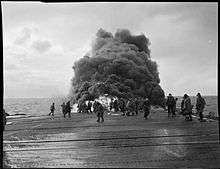HMS Tracker (D24)
| Tracker in circa. 1944 - note the Swordfish with folded wings; a solitary aircraft, probably a Seafire, is at the rear of the flight deck | |
| History | |
|---|---|
| Name: | HMS Tracker |
| Builder: | Seattle-Tacoma Shipbuilding Corporation |
| Laid down: | 3 November 1941 |
| Launched: | 7 March 1942 |
| Commissioned: | 31 January 1943 |
| Decommissioned: | 2 November 1946 |
| Fate: | Sold into merchant service as the Corrientes. Scrapped in 1964. |
| General characteristics | |
| Class and type: | Bogue class escort carrier |
| Displacement: | 14,400 tons |
| Length: | 492 ft (150 m) |
| Beam: | 102 ft 6 in (31.24 m) |
| Draught: | 26 ft 3 in (8.00 m) |
| Propulsion: | Steam turbines, one shaft, 8,500 shp (6.3 MW) |
| Speed: | 18 knots (33 km/h) |
| Complement: | 646 officers and men |
| Armament: |
|
| Aircraft carried: | 16-21 |
| Service record | |
| Operations: | Battle of the Atlantic, Normandy Landings |
| Victories: | Sank U-288 |
HMS Tracker (D24) was a Attacker class escort carrier that was built in the United States, but served in the Royal Navy during World War II.
History
Tracker was constructed in the US by Seattle-Tacoma Shipbuilding in Tacoma, she was originally intended to be the 2nd replacement merchant ship Mormacmail for Moore-McCormack Lines, Inc.. However, before completion, the vessel was purchased by the US Navy; in 1942 she was given the designation BAVG-6 and converted into an escort carrier at Willamette Iron & Steel, Portland, Oregon. Upon completion in early 1943, she was transferred to the Royal Navy and renamed HMS Tracker.
Tracker served as an escort during 1943-44 for North Atlantic and Arctic convoys. She originally carried Swordfish torpedo-bombers and Seafire fighters of 816 Naval Air Squadron; in January 1944 switching to the Grumman Avengers and Grumman Wildcats of 846 Naval Air Squadron. In April 1944 her aircraft, together with those from HMS Activity were responsible for the sinking of a German U-boat U-288 east of Bear Island, during convoy JW-58.
On 10 June 1944 while part of the antisubmarine screen of the Western Approaches Command for the D-Day landings, she collided with a River class frigate of the Royal Canadian Navy, HMCS Teme, causing damage to both ships. HMS Tracker continued operations despite stove-in bows until 12 June 1944. Thereafter she was repaired and partially refitted in Liverpool until 7 September 1944. On 8 December 1944 the ship sailed to the US to be used as an aircraft transport, and spent the remainder of the war ferrying aircraft and personnel in the Pacific.
In August 1945 she made a final trip to the UK, being returned to the US Navy in November 1945. She was sold in November 1946 and entered service as the merchant ship Corrientes, based in Argentina. She was scrapped in 1964.
Battle Honours
- 1943 - 44 Atlantic
- 1944 Arctic
- 1944 Normandy

Design and description
These ships were larger and had a greater aircraft capacity than all the preceding American built escort carriers. They were also laid down as escort carriers and not converted merchant ships.[1] All the ships had a complement of 646 men and an overall length of 492 feet 3 inches (150.0 m), a beam of 69 feet 6 inches (21.2 m) and a draught of 25 ft 6 in (7.8 m).[1] Propulsion was provided by two boilers connected to a steam turbine, which drove one shaft giving 9,350 brake horsepower (SHP). This arrangement could propel the ship at 16.5 knots (30.6 km/h; 19.0 mph).[2]
Aircraft facilities were a small combined bridge/flight control on the starboard side, two aircraft lifts 43 feet (13.1 m) by 34 feet (10.4 m), one aircraft catapult and nine arrestor wires.[1] Aircraft could be housed in the 260 feet (79.2 m) by 62 feet (18.9 m) hangar below the flight deck.[1] Armament comprised: two 4 inch Dual Purpose guns in single mounts, sixteen 40 mm Bofors anti-aircraft guns in twin mounts and twenty 20 mm Oerlikon anti-aircraft cannons in single mounts.[1] The ships had a maximum aircraft capacity of twenty-four which could be a mixture of Grumman Martlets, Vought F4U Corsairs or Hawker Sea Hurricane fighter aircraft and Fairey Swordfish or Grumman Avenger anti-submarine torpedo bombers.[1]
Notes
References
- Cocker, Maurice (2008). Aircraft-Carrying Ships of the Royal Navy. Stroud, Gloucestershire: The History Press. ISBN 978-0-7524-4633-2.
- "Royal Navy Research Archive".
- "World Aircraft Carrier Lists".
- "Royal Navy Escort Carriers".
- by Lt Cdr Geoffrey B Mason RN (Rtd) (2006). "HMS TRACKER (D 24) - Attacker-class Escort Aircraft Carrier". SERVICE HISTORIES of ROYAL NAVY WARSHIPS in WORLD WAR 2. naval-history.net.
revised 18/03/10
- by Lt Cdr Geoffrey B Mason RN (Rtd) (2006). "HMS TRACKER (D 24) - Attacker-class Escort Aircraft Carrier". SERVICE HISTORIES of ROYAL NAVY WARSHIPS in WORLD WAR 2. naval-history.net.
External links
| Wikimedia Commons has media related to HMS Tracker (D24). |

